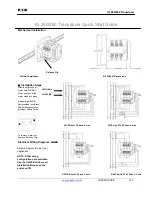
5
Tel: 1/888/525-7300 • Fax: 1/435/753-7490 • www.apgsensors.com • [email protected]
Chapter 2: Installation and Removal Procedures and Notes
•
Mounting Instructions
Mounting your pressure transducer is easy if you follow a few simple steps:
•
Ensure that the fitting on your sensor matches the fitting on your tank/vessel/pipe/etc. If the fittings do
not match, do not attempt to install the sensor. Contact the factory immediately.
•
Never over-tighten the sensor. This can compress the diaphragm, changing how it reacts to pressure.
In all cases, tighten the sensor as little as possible to create an adequate seal. On straight threads,
tighten only until you feel the o-ring compress - making sure you don’t damage or extrude the o-ring.
•
Always use thread tape or sealant compound on tapered threads. Wrap thread tape in the opposite
direction of the threads so it does not unravel as you screw the sensor into place. Unraveling can cause
uneven distribution and seal failure. For straight threads, use an o-ring.
•
Always start screwing in your sensor by hand to avoid cross-threading. Thread failure can be a problem
if you damage threads by over-tightening them or by crossing threads.
•
Wrench sized appropriately for your PT-400’s process connection.
•
Thread tape or sealant compound for threaded connections.
•
Tools Needed
The PT-400 should be installed in an area--indoors or outdoors--which meets the following conditions:
•
Ambient temperature between -40°C and 85°C (-40°F to +185°F)
•
Relative humidity up to 100%
•
Altitude up to 2000 meters (6560 feet)
•
IEC-664-1 Conductive Pollution Degree 1 or 2
•
IEC 61010-1 Measurement Category II
•
No chemicals corrosive to stainless steel (such as NH
3
, SO
2
, Cl
2
etc.)
•
Ample space for maintenance and inspection
•
Class II power supply
•
Physical Installation Notes








































